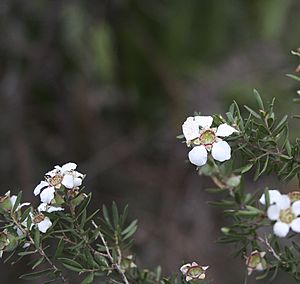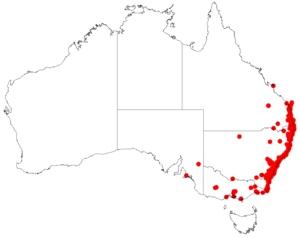Leptospermum juniperinum facts for kids
Quick facts for kids Prickly tea-tree |
|
|---|---|
 |
|
| At Somersby | |
| Scientific classification | |
| Genus: |
Leptospermum
|
| Species: |
juniperinum
|
 |
|
| Occurrence data from AVH | |
The Prickly Tea Tree, also known by its scientific name Leptospermum juniperinum, is a type of shrub that looks a bit like a broom. It grows naturally only in eastern Australia. This plant has thin, pointy leaves, white flowers that usually grow one by one, and small fruits that stay on the plant even when they are ripe.
What the Prickly Tea Tree Looks Like
The Prickly Tea Tree is a shrub that often grows to be about 2 to 3 meters (6.5 to 10 feet) tall. It has thin, rough bark on its branches.
Its leaves are narrow and shaped like a spear, usually 5 to 15 millimeters (0.2 to 0.6 inches) long and 1 to 2 millimeters (0.04 to 0.08 inches) wide. Each leaf has a very sharp, pointed tip.
The flowers are usually white and grow by themselves on short side branches. They are about 6 to 10 millimeters (0.2 to 0.4 inches) wide. The small stalk that holds the flower, called a pedicel, is less than 1 millimeter long.
The part of the flower that holds the petals and other parts, called the floral cup, is about 1.5 to 2 millimeters long. The sepals, which are like small leaves protecting the bud, are egg-shaped and about 1.6 millimeters long. The white petals are often about 3.5 millimeters long, and the stamens (the parts that make pollen) are 1 to 1.5 millimeters long.
Prickly Tea Trees mostly bloom from November to December. After flowering, they produce a small fruit called a capsule, which is usually less than 7 millimeters wide. These fruits stay on the plant even after they are fully grown.
How the Prickly Tea Tree Got Its Name
The Prickly Tea Tree, Leptospermum juniperinum, was first officially described in 1797. This was done by a scientist named James Edward Smith in a publication called Transactions of the Linnean Society of London.
The second part of its scientific name, juniperinum, comes from the word "juniper." This is because people thought the plant looked similar to Juniper plants.
Where the Prickly Tea Tree Grows
The Prickly Tea Tree grows in swamps near the coast, in areas with heathland, and in places with sedges. You can also find it on sandstone cliffs. It grows along the eastern coast of Australia, from Fraser Island in Queensland down to Ulladulla in New South Wales.

